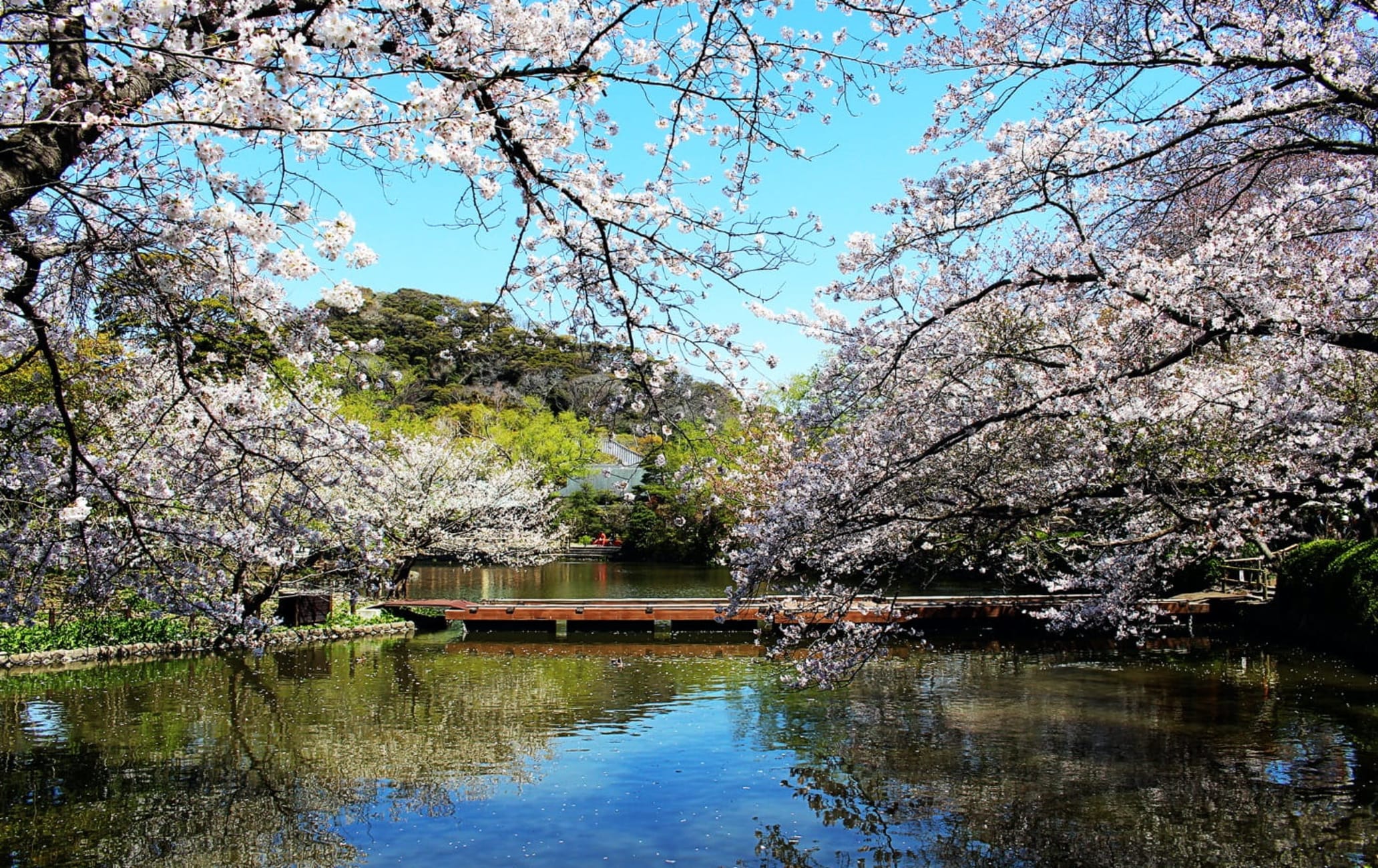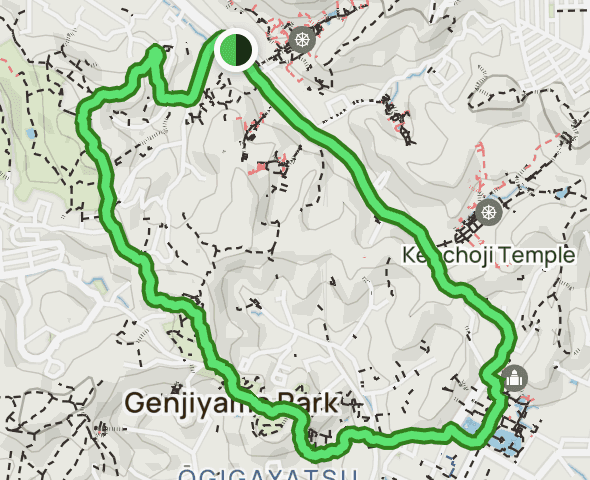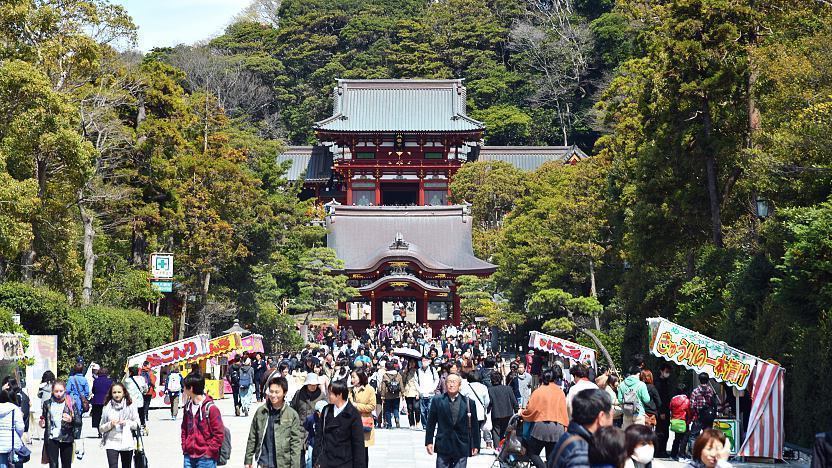Win a Free Trip to Japan!
Experience cherry blossoms and ancient temples
Embarking on a journey from Tsurugaoka Hachimangu to Kamakura Station offers a captivating blend of history and natural beauty. This scenic route, deeply rooted in Japanese culture, invites travelers to explore stunning landscapes, historical landmarks, and vibrant wildlife. As you walk along this picturesque pathway, you will not only appreciate the serene environment but also encounter essential cultural stops that enrich your experience. Discovering the remarkable connections between these two points enhances your appreciation of both the iconic shrine and the charming coastal town of Kamakura.
Importance of Tsurugaoka Hachimangu in Kamakura
Tsurugaoka Hachimangu serves as a cultural and historical cornerstone of Kamakura, attracting visitors from all around. This Shinto shrine, established in 1063, is dedicated to Hachiman, the god of war and protector of the samurai class. Its significance in the region can be summed up as follows:
- Historical Landmark: Tsurugaoka Hachimangu played a crucial role during the Kamakura period (1185-1333) as a site of political power and religious influence.
- Architectural Splendor: The shrine features stunning architecture, including intricate wooden gates and picturesque gardens, reflecting traditional Japanese style.
- Cultural Events: Throughout the year, the shrine hosts various festivals which showcase traditional music, dance, and rituals, thereby preserving the local culture.
- Tourist Attraction: It draws numerous tourists each year, fueling the local economy. Its proximity to the scenic route connecting Tsurugaoka Hachimangu to Kamakura Station further enhances its accessibility.
In summary, Tsurugaoka Hachimangu is not just a religious site but a vibrant symbol of Kamakura’s rich history and culture. By walking the scenic route from Tsurugaoka Hachimangu to Kamakura Station, visitors can experience both the beauty of the shrine and the enchanting surroundings of the city.

Overview of the Scenic Route
The journey from Tsurugaoka Hachimangu to Kamakura Station offers a delightful blend of nature and culture. This scenic route is approximately 2 kilometers (1.2 miles) long, making it an ideal walk for both tourists and locals. Here’s what you can expect along the way:
- Historical Pathways: The route is steeped in history, tracing paths used by Japanese royalty and samurai.
- Cultural Landmarks: As you walk, you’ll encounter various shrines, temples, and traditional Japanese architecture, enriching your experience.
- Natural Beauty: Lush greenery, seasonal flowers, and serene landscapes surround you, inviting you to pause and appreciate the view.
| Feature | Details |
|---|---|
| Distance | Approximately 2 km |
| Walking Duration | Around 30-40 minutes |
| Terrain | Mostly flat with some gentle slopes |
| Accessibility | Suitable for all ages and fitness levels |
This picturesque route not only connects Tsurugaoka Hachimangu to Kamakura Station, but also provides immersive experiences, from vibrant cherry blossoms in spring to the vibrant colors of autumn leaves. Whether you are an avid history buff or simply in search of a tranquil stroll, this pathway caters to all. Plus, with numerous rest spots along the way, you can fully enjoy this iconic journey through Kamakura.
Historical Significance of the Pathway
Walking the route from Tsurugaoka Hachimangu to Kamakura Station offers not just breathtaking views, but also a glimpse into Kamakura’s rich history. This pathway showcases the cultural evolution of Japan during the Kamakura period (1185–1333). Here’s why this route is historically significant:
- Ancient Pilgrimage Road: Originally, this pathway served as a pilgrimage route for worshippers traveling to Tsurugaoka Hachimangu, dedicated to the deity Hachimangu, the protector of warriors and a symbol of loyalty.
- Cultural Development: The establishment of Tsurugaoka Hachimangu marked the rise of Kamakura as a political center. As you stroll along, you encounter shrines, historical landmarks, and monuments that reflect the city’s transformation from a remote village to a seat of power.
- Architectural Heritage: Various structures along the path, like traditional Japanese gates and stone lanterns, highlight the architectural styles and spiritual significance of the era. These elements provide a peek into the craftsmanship of yesteryears.
- Symbolic Connection: The pathway represents the spiritual journey between the sacred (Tsurugaoka Hachimangu) and the everyday life found near Kamakura Station, symbolizing a blend of spirituality and modernity.
Understanding this historical significance enriches your experience, making your walk from Tsurugaoka Hachimangu to Kamakura Station not just a scenic stroll, but a voyage through time.
Natural Landscapes Along the Route
Walking from Tsurugaoka Hachimangu to Kamakura Station offers a feast for the senses, showcasing some of the most beautiful natural landscapes in the area. The route features a harmonious blend of cultural and natural sights, making the journey as rewarding as the destination itself.
Key Features of the Landscapes:
- Lush Greenery: The pathway is lined with vibrant trees, including cherry blossoms in spring and colorful foliage in autumn. These seasonal changes create picturesque views that delight travelers year-round.
- Serene Waterways: Keep an eye out for small streams and ponds along the way. The gentle sounds of flowing water enhance the tranquility of your walk, providing a soothing backdrop to your exploration.
- Mountainous Backdrop: The hills surrounding Kamakura add a dramatic touch to the landscape. Take a moment to pause and appreciate the contrast between the ornate shrine and the rugged terrain.
- Coastal Views: As you approach Kamakura Station, glimpses of the ocean emerge, creating breathtaking panoramas that captivate the senses.
Summary Table of Landscape Highlights:
| Feature | Description |
|---|---|
| Greenery | Cherry blossoms, autumn foliage |
| Waterways | Streams and ponds for peaceful ambiance |
| Mountain Views | Scenic hills surrounding the area |
| Coastal Views | Stunning ocean panoramas at journey’s end |
In conclusion, the natural landscapes along the Tsurugaoka Hachimangu to Kamakura Station route offer an enriching experience, blending nature with historical significance. Enjoy every moment of your journey!

Cultural Stops and Landmarks
Walking the tsurugaoka hachimangu to kamakura station route offers a rich tapestry of cultural stops and landmarks. As you embark on this journey, make sure to explore the following highlights:
- Tsurugaoka Hachimangu Shrine: This iconic shrine, dedicated to the patron god of warriors, serves as the starting point. Its majestic approach lined with cherry blossoms is a stunning sight, especially in spring.
- Komachi Street: Just a short stroll from the shrine, this bustling street features traditional shops, crafts, and food stalls. It’s the perfect spot to experience local culture and pick up unique souvenirs.
- Daitoku-in Temple: Nestled within a serene garden, this temple is an excellent place to reflect and enjoy its splendid landscape. It showcases beautiful Zen gardens and historic architecture.
- Hase-dera Temple: Located slightly off the main path, this temple is worth a detour. Its breathtaking views of Kamakura and the Great Buddha statue make it a memorable stop.
- Kamakura Museum of Literature: This cultural gem offers insights into the literary history of the region. The museum hosts a range of exhibitions focusing on notable authors connected to Kamakura.
- Buddhist Stupas: As you make your way to kamakura station, you’ll encounter several historical stupas that tell stories of Kamakura’s past and spiritual heritage.
By incorporating these cultural stops along the tsurugaoka hachimangu to kamakura station route, you will deepen your understanding of the region’s rich history and traditions, making your journey all the more rewarding.
Wildlife and Flora Encountered
Walking the scenic route from Tsurugaoka Hachimangu to Kamakura Station offers a delightful experience not only for the historical and cultural significance but also for the rich biodiversity that flourishes along the path. Here’s what you can expect:
Wildlife:
- Bird Species: Keep an eye out for various birds such as Japanese White-eye, Japanese Robin, and Sparrows that thrive in the area.
- Squirrels: These playful creatures often dart among the trees, adding a playful energy to your walk.
- Insects: During warmer months, witness butterflies and a variety of bees diligently pollinating the flowers.
Flora:
- Cherry Blossoms: In spring, the cherry blossoms create a breathtaking canopy of pink that enhances the journey.
- Maples: Japanese maples dazzle in autumn with their vibrant red and orange leaves, drawing nature lovers.
- Bamboo Groves: These striking groves provide a serene backdrop and a unique soundtrack as the wind rustles through the leaves.
Comparison of Flora by Season:
| Season | Notable Flora |
|---|---|
| Spring | Cherry Blossoms, Azaleas |
| Summer | Hydrangeas, Hostas |
| Autumn | Maples, Goldenrods |
| Winter | Camellias |
Experience the harmony of nature as you walk from Tsurugaoka Hachimangu to Kamakura Station. The route not only helps you connect with Japan’s rich culture but also immerses you in its stunning wildlife and flora.
Tips for Walking the Scenic Route
Walking from Tsurugaoka Hachimangu to Kamakura Station offers an exquisite blend of nature and culture. To enhance your experience, consider the following tips:
- Wear Comfortable Shoes: The pathway features a mix of terrains, including paved roads and rustic trails. Opt for sturdy, breathable footwear.
- Plan Your Timing: Start early in the day to maximize daylight. This route can take approximately 30-40 minutes, depending on your pace and stops along the way.
- Stay Hydrated: Bring a water bottle to stay refreshed, especially during warmer months. There are also rest areas where you can refill.
- Schedule Breaks: Make the most of your stroll by taking breaks at scenic spots or cultural landmarks. This allows you to fully appreciate the beauty of Tsurugaoka Hachimangu to Kamakura Station.
- Check the Weather: Weather can change quickly. Dress in layers and carry a small umbrella or jacket to prepare for any changes.
- Capture the Moments: Don’t forget your camera! The landscape is picturesque, adorned with seasonal flowers and stunning views.
- Explore Local Eateries: Keep an eye out for quaint cafes and snack shops along the route. It’s a fantastic opportunity to taste local cuisine.
By following these tips, you’ll enjoy a memorable and enriching experience on your journey from Tsurugaoka Hachimangu to Kamakura Station. Happy walking!

Local Eateries and Refreshment Options
Strolling from Tsurugaoka Hachimangu to Kamakura Station unveils not only panoramic views but also a delightful array of local eateries and refreshment options. This journey boasts culinary treasures that enhance your experience along the scenic route.
Recommended Eateries
-
Kamakura Pasta
- Specializes in handmade pasta dishes
- Offers vegetarian options
-
Hachiman Sushi
- Fresh sushi made with local ingredients
- Ideal for a quick bite
-
Kamakura Coffee
- Perfect for a rejuvenating coffee break
- Renowned for its artisanal brews
Snack and Refreshment Options
-
Mochi Hiyashi
- A local favorite, this cold mochi offers a refreshing taste.
- Great to enjoy as you explore.
-
Yaki Imo Stands
- Sweet roasted sweet potatoes, a seasonal delight.
-
Green Tea Shops
- Traditional options selling freshly brewed matcha.
- A calming beverage to savor while enjoying the scenery.
Considerations
While following the tsurugaoka hachimangu to kamakura station, keep these tips in mind:
- Plan to take breaks at eateries along the route.
- Try local specialties to enrich your cultural experience.
- Consider visiting during lunchtime or late afternoon to avoid crowds.
In summary, the variety of local eateries and refreshment options adds to the appeal of the scenic walk from Tsurugaoka Hachimangu to Kamakura Station. Enjoy delicious meals and unique treats that truly represent Kamakura’s flavor and culture!
Best Times to Experience the Route
Walking the scenic route from Tsurugaoka Hachimangu to Kamakura Station offers a fresh perspective on Kamakura’s rich history and natural beauty. However, timing your visit enhances the experience significantly. Here are the best times to explore this route:
Spring (March to May)
- Cherry Blossoms: Experience breathtaking views of sakura trees in full bloom, particularly around late March and early April.
- Mild Weather: Average temperatures range from 10°C to 20°C, providing comfortable walking conditions.
Summer (June to August)
- Vibrant Greenery: Witness lush landscapes, but prepare for humidity and occasional rain.
- Festivals: Engage in local summer festivals that provide cultural experiences along the path.
Autumn (September to November)
- Fall Foliage: Enjoy stunning autumn colors, especially in late November, making it a fantastic season for photography.
- Cooler Temperatures: Comfortable conditions with decreasing humidity, perfect for walking.
Winter (December to February)
- Peaceful Atmosphere: Fewer tourists offer a serene walking experience, though it can get chilly.
- Cultural Events: Witness New Year celebrations at Tsurugaoka Hachimangu, highlighting its cultural significance.
Conclusion
To optimize your journey from Tsurugaoka Hachimangu to Kamakura Station, consider visiting during spring or autumn for a balance of picturesque scenery and pleasant weather. Each season offers unique experiences, making every visit special.
Conclusion and Final Thoughts on the Journey
Walking the scenic route from tsurugaoka hachimangu to kamakura station offers more than just a pleasant stroll; it is a journey through history, culture, and breathtaking landscapes. As you traverse this path, you experience a blend of spiritual significance and natural beauty that leaves a lasting impression.
Reflecting on this experience, here are some key takeaways:
- Cultural Enrichment: The journey allows for an intimate glimpse into Japan’s rich heritage. You encounter ancient shrines, traditional architecture, and local customs that provide context to the modern-day surroundings.
- Natural Beauty: The lush greenery and picturesque views along the way showcase Kamakura’s stunning environment. From cherry blossoms in spring to the vibrant foliage of autumn, each season presents unique charms.
- Accessibility: The route is easy to navigate, making it suitable for walkers of all ages. Efforts to maintain paths ensure a pleasant experience whether you are a seasoned hiker or a casual walker.
In conclusion, the tsurugaoka hachimangu to kamakura station route not only serves as a physical connection between two pivotal locations but also connects visitors to Japan’s profound spiritual and natural landscape. As you reflect on this journey, consider setting aside time during your next visit to fully immerse yourself in this beautiful experience.
Frequently Asked Questions
What is the best way to travel from Tsurugaoka Hachimangu to Kamakura Station?
The best way to travel from Tsurugaoka Hachimangu to Kamakura Station is on foot, as the distance is about 1.4 kilometers, which takes roughly 20 to 25 minutes to walk. This scenic route allows you to enjoy the beautiful landscapes, historical architecture, and charming streets of Kamakura. Alternatively, you can take a local bus or a taxi if you prefer a quicker and more comfortable journey.
Are there any attractions to see along the route from Tsurugaoka Hachimangu to Kamakura Station?
Yes, there are several attractions worth seeing along the route from Tsurugaoka Hachimangu to Kamakura Station. You can explore the vibrant Komachi Street, known for its shops, cafes, and food stalls. Additionally, the nearby Hasedera Temple offers stunning gardens and panoramic views of the area. The path is dotted with beautiful seasonal flowers and local art, making it a delightful journey for visitors.
What is the historical significance of Tsurugaoka Hachimangu?
Tsurugaoka Hachimangu is a significant Shinto shrine in Kamakura, established in 1063 by Minamoto no Yorimasa. It is dedicated to Hachiman, the patron deity of the samurai, and has historical significance as a center of political power in the Kamakura period. The shrine features beautiful architecture, including a grand entrance gate and numerous sacred sakura trees, making it a prime destination for history enthusiasts and spiritual seekers.
What is the best time of year to visit the route between Tsurugaoka Hachimangu and Kamakura Station?
The best time to visit the route between Tsurugaoka Hachimangu and Kamakura Station is during the spring (March to May) and autumn (September to November). In spring, cherry blossoms adorn the landscape, creating a breathtaking view, while autumn brings vibrant hues of red and orange foliage. These seasons provide pleasant weather and numerous seasonal events, enhancing the overall experience of exploring Kamakura.
Are there any local food specialties to try along the walking route?
Absolutely! Along the walking route from Tsurugaoka Hachimangu to Kamakura Station, you can try Kamakura’s local food specialties. Notable dishes include ‘shirasu’ (whitebait, often served raw or cooked), ‘nerikiri’ (a traditional sweet made with rice and bean paste), and various types of soba noodles. Komachi Street is famous for its street food stalls featuring delicious snacks like matcha soft-serve ice cream and sweet potato chips.
